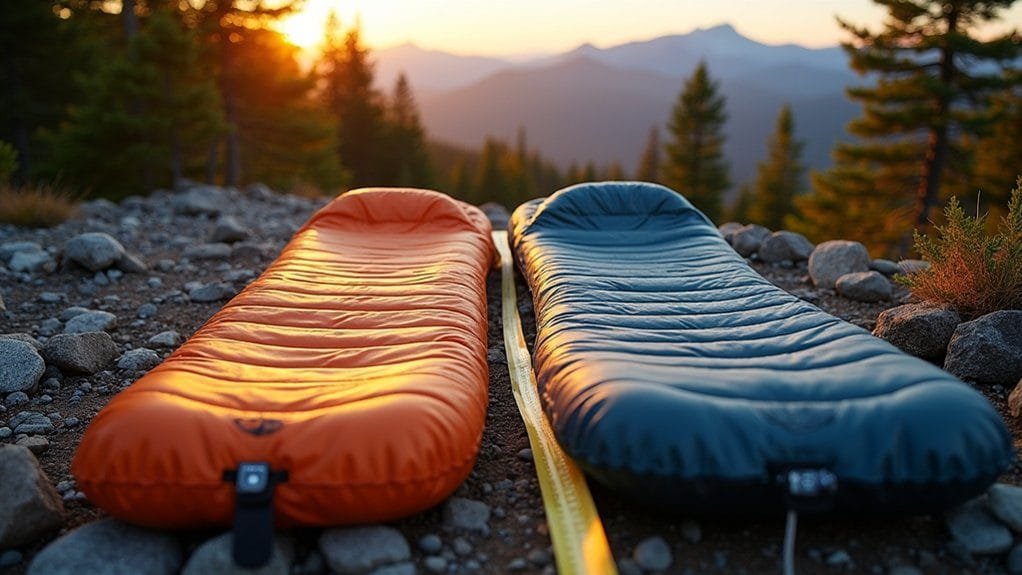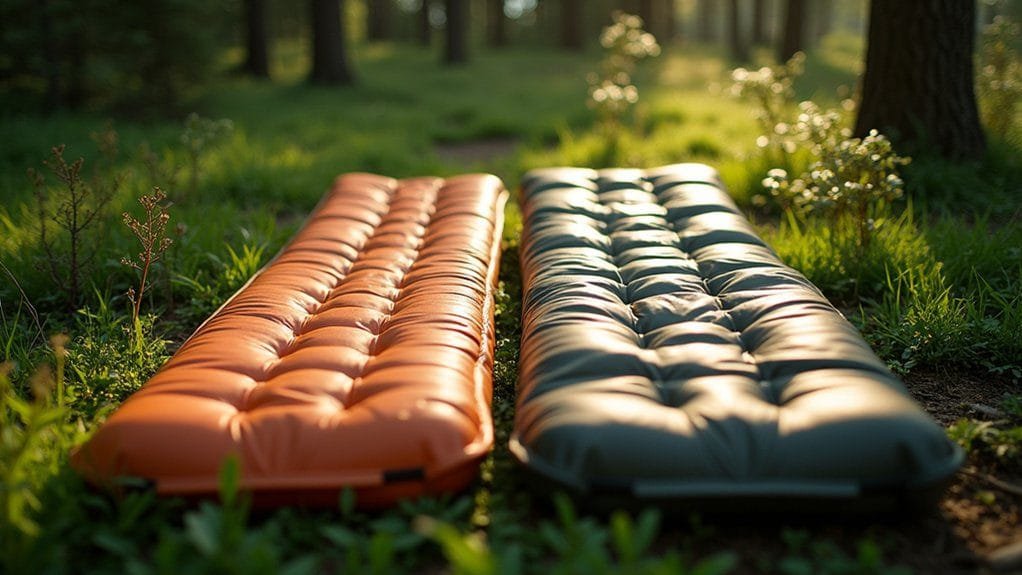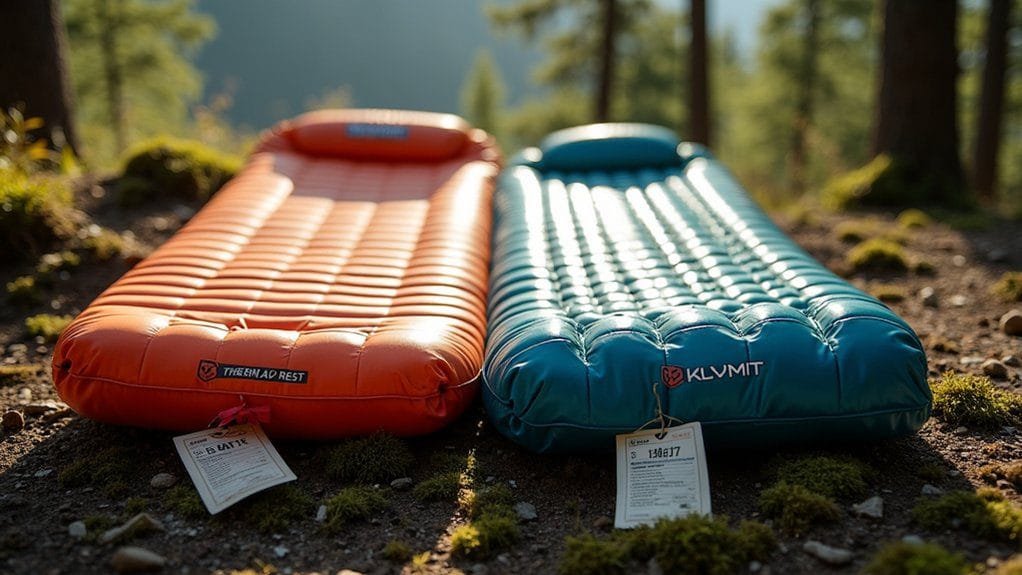When choosing between Therm-a-Rest and Klymit sleeping pads, you’ll want to prioritize your specific backpacking needs. Therm-a-Rest offers superior insulation with R-values up to 7.3, making it ideal for extreme cold, while Klymit provides budget-friendly options better suited for summer trips. The NeoAir XTherm NXT excels in weight, packability, and warmth, outperforming Klymit’s Static V2. Your perfect pad awaits in the details ahead.
Key Takeaways
- Therm-a-Rest offers superior insulation with higher R-values (up to 7.3), making it ideal for extreme cold and multi-season backpacking adventures.
- Klymit provides more budget-friendly options, with sleeping pads ranging from $59-$89, making them attractive for cost-conscious outdoor enthusiasts.
- Weight considerations favor Therm-a-Rest, with ultralight models like NeoAir XLite NXT weighing just 12.5 oz compared to Klymit’s heavier 18 oz pads.
- Comfort differs between brands, with Therm-a-Rest featuring advanced thickness (3 inches) and grip surfaces, while Klymit offers wider shapes for diverse sleeping positions.
- Temperature performance varies significantly, with Therm-a-Rest capable of protecting users in temperatures down to -40°F, compared to Klymit’s more limited summer-focused designs.
Top Performance Metrics


When evaluating sleeping pads for backpacking, performance metrics provide critical insights into their suitability for different outdoor conditions. Therm-a-Rest and Klymit offer distinct options with varying capabilities. The NeoAir XTherm NXT demonstrates superior insulation with an exceptional R-value of 7.3, making it ideal for extreme cold environments, while the Klymit Static V2’s R-value of 1.3 limits its cold-weather performance. Comfort ratings further differentiate these sleeping pads, with Therm-a-Rest scoring 8.0 compared to Klymit’s 7.0. Construction quality matters greatly, as Therm-a-Rest utilizes 30D durable materials for enhanced puncture resistance. Both brands prioritize lightweight backpacking gear, with compact packed sizes that won’t weigh down your pack. Your choice depends on specific trip requirements, temperature ranges, and personal comfort preferences.
Weight and Packability Comparison
How critical is weight and packability for backpackers trudging miles through rugged terrain? When comparing Therm-a-Rest and Klymit sleeping pads, every ounce matters. The NeoAir XLite NXT stands out with its remarkable 12.5 oz weight and Nalgene-sized packability, while the Klymit Static V2 weighs 18 oz and occupies more backpack space.
Key considerations for backpackers include:
- Ultralight design prioritizes minimal weight
- Compact size enables easier trail mobility
- Insulation performance balanced with portability
- R-value determines cold-weather effectiveness
The Therm-a-Rest NeoAir XTherm NXT demonstrates superior weight-to-insulation ratio, offering 16 oz of reliable warmth with an impressive R-value of 7.3. For backpackers seeking peak performance, Therm-a-Rest’s innovative designs provide more portable and efficient sleeping pad solutions compared to Klymit’s bulkier alternatives.
Comfort and Design Analysis


Beyond weight considerations, sleeping pad design directly impacts a backpacker’s trail comfort and recovery. The Therm-a-Rest NeoAir XLite NXT offers superior comfort with its 3-inch thickness and R-value of 4.5, providing robust insulation across various sleeping positions. Its grippy surface material enhances stability, preventing unwanted nighttime movement. In contrast, the Klymit Static V Insulated features a wider shape that accommodates side and belly sleepers, though its lower R-value of 1.3 limits cold-weather performance. While both pads prioritize lightweight and compact design for backpacking, Therm-a-Rest’s construction seems more refined for comfort and thermal efficiency. When selecting an insulated sleeping pad, you’ll want to balance thickness, R-value, and surface ergonomics to guarantee ideal trail recovery and comfort.
R-Value and Insulation Capabilities
Since thermal performance is critical for backpackers traversing diverse environments, the R-value serves as the definitive metric for evaluating sleeping pad insulation. When comparing the Therm-a-Rest NeoAir XTherm NXT and Klymit Static V2, the stark differences in R-value become evident:
- The XTherm NXT offers an exceptional R-value of 7.3, making it warm enough for extreme cold conditions down to -40°F
- Klymit’s Static V2, with a minimal R-value of 1.3, is primarily suited for summer backpacking
- Lightweight sleeping pads like the NeoAir XLite NXT provide a balanced R-value of 4.5 for three-season use
- Closed-cell foam pads typically offer less insulation compared to advanced inflatable designs
Your choice depends on anticipated temperature ranges and desired balance between adequate insulation and pack weight, ensuring ideal thermal protection during your outdoor adventures.
Price Point Evaluation


Three key price tiers emerge when evaluating sleeping pad options for backpackers: budget, mid-range, and premium. The Klymit Static V Insulated represents a budget-friendly option at $59, offering a cost-effective sleeping pad for price-conscious adventurers. In the mid-range category, the Therm-a-Rest NeoAir XLite NXT provides advanced insulation and lightweight design at approximately $200. For those demanding extreme performance, the Therm-a-Rest NeoAir XTherm NXT commands a premium price of $250, delivering a high R-value of 7.3 and exceptional durability. Klymit’s Static V Luxe SL balances comfort over weight at $89, while the NEMO Switchback offers a viable alternative at $50 for summer use. Your price point evaluation should consider performance requirements, intended terrain, and personal budget constraints when selecting the ideal sleeping pad.
User Experience and Field Testing
After analyzing price considerations, real-world performance becomes the true measure of a sleeping pad’s value. Field testing reveals distinct characteristics of the Therm-a-Rest NeoAir XLite NXT and Klymit Static V Insulated:
- The Therm-a-Rest NeoAir XLite NXT delivers a comfortable sleeping experience with its 4.5 R-value, making it versatile for three-season backpacking.
- Klymit’s pad impresses with its compact size, packing down smaller than a pop can, yet its 1.3 R-value limits cold weather performance.
- The Therm-a-Rest XTherm NXT stands out in extreme conditions, offering excellent warmth with a 7.3 R-value for winter backpacking.
- Klymit’s responsive customer service provides additional confidence, quickly addressing potential pad issues like leaks.
User experience ultimately hinges on matching the right pad to specific environmental conditions and personal comfort requirements.
Frequently Asked Questions
What Is the Most Comfortable Sleeping Pad for Backpacking?
You’ll want the Nemo Tensor or Therm-a-Rest NeoAir XLite for top comfort, balancing lightweight design, superior insulation, and robust temperature ratings. These pads offer excellent support, durability, and packability for serious backpackers seeking peak sleeping performance.
What Is the Best Thermarest Sleeping Pad for Backpacking?
The NeoAir XLite NXT is your best Therm-a-Rest option, offering lightweight (12.5 oz) design, R-value of 4.5, compact size, reduced noise, and comfort. It’s versatile, durable, and highly rated for most backpacking conditions.
What Is the Best Sleeping Bag for Backpacking?
You’ll want a lightweight mummy-shaped down sleeping bag with a 20-30°F rating, featuring hydrophobic insulation and water-resistant shell. Consider packability, durability, and temperature versatility to optimize your backpacking gear performance across varied outdoor conditions.
Are Klymit Sleeping Pads Noisy?
Klymit sleeping pads produce noticeable noise due to their material composition and inflation design. You’ll experience crinkling sounds during movement, which can impact comfort in quiet outdoor environments, though many users find the trade-offs acceptable for lightweight performance.
Conclusion
When you’re choosing between Therm-a-Rest and Klymit, it’s like selecting a trusty trail companion for your backcountry adventures. Both brands pack a punch, but your ideal sleeping pad depends on your specific needs. Whether you prioritize ultralight design or maximum insulation, each brand offers unique strengths that can transform your outdoor sleeping experience from uncomfortable to cloud-like comfort. Choose wisely, and your nights under the stars will never be the same.
